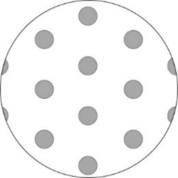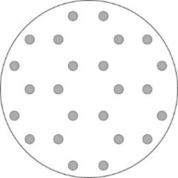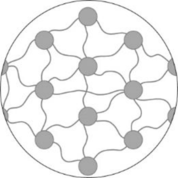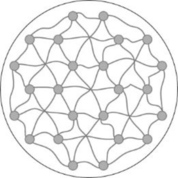
Concept explainers
(1)
To draw: A cross-section diagram that shows in the H zone.
Introduction: Myofilaments within the myofibrils are organized in a continuous manner with cylindrical units called sarcomeres. Inside the skeletal muscle fibers, there are several repeating sarcomeres arranged within a section of a myofibril. Overlapping of thick and thin filaments constitutes each sarcomere.
(1)
Explanation of Solution
Pictorial representation: Fig.1 represents the H zone though cross-section of muscle fiber.

Fig.1: H zone
H zone is the central portion of the A band that is present only in the resting sarcomere. The H zone region does not have overlapping thin filament. It only has thick filament.
(2)
To draw: A cross-section diagram that shows in the I band.
(2)
Explanation of Solution
Pictorial representation: Fig.1 represents the I band though cross-section of muscle fiber.

Fig.1: I zone
I band is the only region that contains thin filament and extends from both directions of Z disk. At the region of maximal shortening, the thin filaments of the muscle fiber are pulled parallel along the thick filaments. This leads to decrease of I bands.
(3)
To draw: A cross-section diagram that shows at the M line.
(3)
Explanation of Solution
Pictorial representation: Fig.1 represents the M line though cross-section of muscle fiber.

Fig.1: M line
M line is the narrow, dark band in the center region of the H zone known as M line that corresponds to proteins link together at the central region of the adjacent thick filament.
(4)
To draw: A cross-section diagram that shows in the Z line.
(4)
Explanation of Solution
Pictorial representation: Fig.1 represents the Z line though cross-section of muscle fiber.

Fig.1: Z line
The sarcomeres are composed of thin and thick overlapping filaments. It is delineated by Z disks on both ends. These disks are composed of specialized proteins that are perpendicular to myofilaments and function as an anchor for the thin filament.
Want to see more full solutions like this?
Chapter 9 Solutions
VANDER'S HUMAN PHYS CONNECT ACCESS
- Which of the following is not a DNA binding protein? 1. the lac repressor protein 2. the catabolite activated protein 3. the trp repressor protein 4. the flowering locus C protein 5. the flowering locus D protein 6. GAL4 7. all of the above are DNA binding proteinsarrow_forwardWhat symbolic and cultural behaviors are evident in the archaeological record and associated with Neandertals and anatomically modern humans in Europe beginning around 35,000 yBP (during the Upper Paleolithic)?arrow_forwardDescribe three cranial and postcranial features of Neanderthals skeletons that are likely adaptation to the cold climates of Upper Pleistocene Europe and explain how they are adaptations to a cold climate.arrow_forward
- Biology Questionarrow_forward✓ Details Draw a protein that is embedded in a membrane (a transmembrane protein), label the lipid bilayer and the protein. Identify the areas of the lipid bilayer that are hydrophobic and hydrophilic. Draw a membrane with two transporters: a proton pump transporter that uses ATP to generate a proton gradient, and a second transporter that moves glucose by secondary active transport (cartoon-like is ok). It will be important to show protons moving in the correct direction, and that the transporter that is powered by secondary active transport is logically related to the proton pump.arrow_forwarddrawing chemical structure of ATP. please draw in and label whats asked. Thank you.arrow_forward
- Outline the negative feedback loop that allows us to maintain a healthy water concentration in our blood. You may use diagram if you wisharrow_forwardGive examples of fat soluble and non-fat soluble hormonesarrow_forwardJust click view full document and register so you can see the whole document. how do i access this. following from the previous question; https://www.bartleby.com/questions-and-answers/hi-hi-with-this-unit-assessment-psy4406-tp4-report-assessment-material-case-stydu-ms-alecia-moore.-o/5e09906a-5101-4297-a8f7-49449b0bb5a7. on Google this image comes up and i have signed/ payed for the service and unable to access the full document. are you able to copy and past to this response. please see the screenshot from google page. unfortunality its not allowing me attch the image can you please show me the mathmetic calculation/ workout for the reult sectionarrow_forward
 Human Anatomy & Physiology (11th Edition)BiologyISBN:9780134580999Author:Elaine N. Marieb, Katja N. HoehnPublisher:PEARSON
Human Anatomy & Physiology (11th Edition)BiologyISBN:9780134580999Author:Elaine N. Marieb, Katja N. HoehnPublisher:PEARSON Biology 2eBiologyISBN:9781947172517Author:Matthew Douglas, Jung Choi, Mary Ann ClarkPublisher:OpenStax
Biology 2eBiologyISBN:9781947172517Author:Matthew Douglas, Jung Choi, Mary Ann ClarkPublisher:OpenStax Anatomy & PhysiologyBiologyISBN:9781259398629Author:McKinley, Michael P., O'loughlin, Valerie Dean, Bidle, Theresa StouterPublisher:Mcgraw Hill Education,
Anatomy & PhysiologyBiologyISBN:9781259398629Author:McKinley, Michael P., O'loughlin, Valerie Dean, Bidle, Theresa StouterPublisher:Mcgraw Hill Education, Molecular Biology of the Cell (Sixth Edition)BiologyISBN:9780815344322Author:Bruce Alberts, Alexander D. Johnson, Julian Lewis, David Morgan, Martin Raff, Keith Roberts, Peter WalterPublisher:W. W. Norton & Company
Molecular Biology of the Cell (Sixth Edition)BiologyISBN:9780815344322Author:Bruce Alberts, Alexander D. Johnson, Julian Lewis, David Morgan, Martin Raff, Keith Roberts, Peter WalterPublisher:W. W. Norton & Company Laboratory Manual For Human Anatomy & PhysiologyBiologyISBN:9781260159363Author:Martin, Terry R., Prentice-craver, CynthiaPublisher:McGraw-Hill Publishing Co.
Laboratory Manual For Human Anatomy & PhysiologyBiologyISBN:9781260159363Author:Martin, Terry R., Prentice-craver, CynthiaPublisher:McGraw-Hill Publishing Co. Inquiry Into Life (16th Edition)BiologyISBN:9781260231700Author:Sylvia S. Mader, Michael WindelspechtPublisher:McGraw Hill Education
Inquiry Into Life (16th Edition)BiologyISBN:9781260231700Author:Sylvia S. Mader, Michael WindelspechtPublisher:McGraw Hill Education





